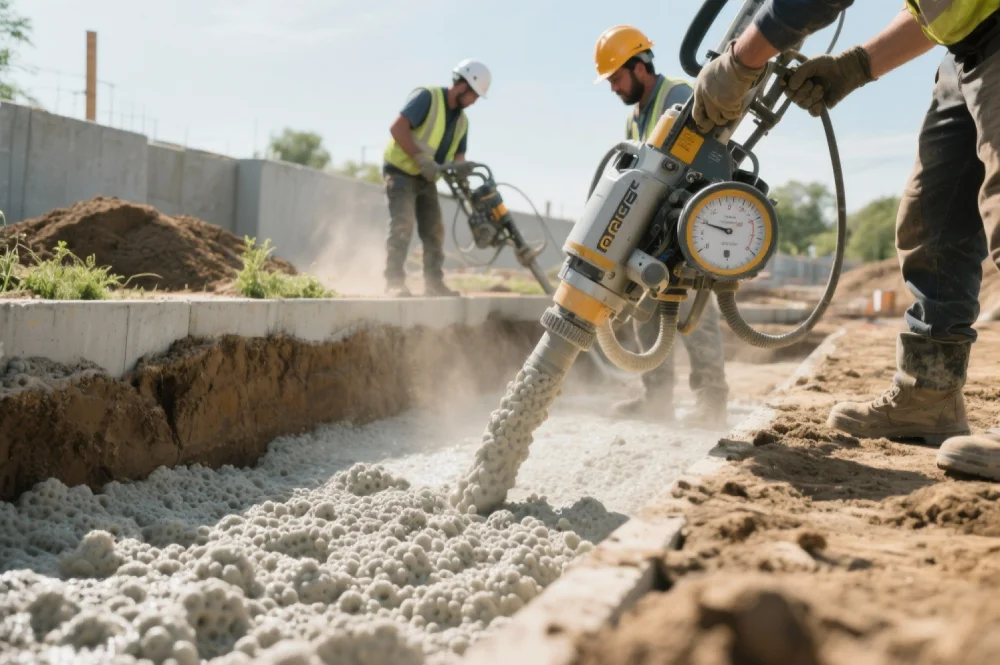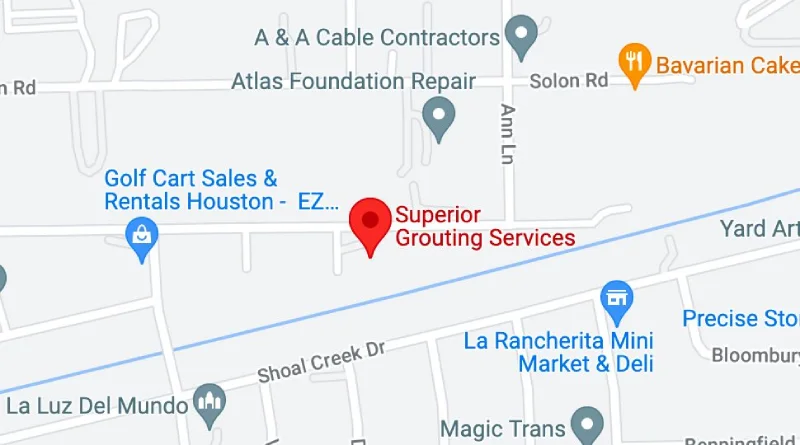Can Cellular Grouting Deliver Lighter, Stronger, and Greener Fills?

Yes, cellular grouting delivers 60-80% lighter fills reducing structural loads, adequate compressive strength (200-800 psi) for 70-80% of applications, superior flowability filling complex voids, and 40-60% lower carbon emissions through reduced material consumption while maintaining durability and cost-effectiveness for infrastructure projects.
Modern construction demands materials balancing multiple objectives: reducing structural loads, providing adequate strength, minimizing environmental impact, and controlling costs. Cellular grouting addresses these competing requirements through foam-based mixtures incorporating air bubbles that create lightweight, flowable, sustainable fills. The technology reduces weight by 60-80% compared to conventional materials while maintaining sufficient strength for most applications. Material efficiency cuts carbon emissions 40-60% supporting sustainability goals. Understanding cellular grout's actual capabilities versus traditional fills helps project teams make informed decisions optimizing performance, cost, and environmental responsibility.
Key Takeaways
- Cellular grout achieves densities of 30-80 pcf (60-80% lighter than conventional fills at 120-150 pcf), reducing foundation loads proportionally and preventing overstress on weak soils while enabling construction in weight-sensitive applications like building additions over existing structures, bridge approach fills, and utility installations in compressible ground.
- Compressive strength of 200-800 psi proves adequate for 70-80% of grouting applications including void filling, utility trench backfill, pavement support, and light structural loads, though heavy structural applications requiring 2,000+ psi may need conventional concrete or compaction grouting depending on specific load requirements and safety factors.
- Superior flowability from air bubble suspension enables pumping 1,000-2,000 feet through small injection ports, filling irregular voids and tight spaces that conventional materials cannot reach, achieving 95-100% void occupation versus 60-80% for granular fills that bridge across openings leaving voids causing future settlement.
- Carbon emissions reduction of 40-60% results from material efficiency (less cement per cubic yard due to air content), reduced transportation fuel (lighter materials requiring fewer truck deliveries), and alternative cementitious materials (fly ash, slag) replacing 30-50% of portland cement in sustainable formulations.
- Quick setting (24-72 hours to working strength) enables faster project completion reducing traffic disruption costs, equipment rental expenses, and business interruption impacts by days or weeks compared to traditional methods requiring extended compaction, testing, and curing periods before structures can be loaded.
- Cost competitiveness results from reduced excavation (fewer access points needed due to pumpability), lower transportation (lighter materials), faster installation (less labor and equipment time), and lifecycle savings (reduced maintenance from superior void filling and settlement prevention) offsetting 10-40% higher material unit costs.
Lightweight Properties and Load Reduction
Cellular grout's reduced density provides the foundation for multiple performance advantages.
Density Comparison and Applications
Air bubble incorporation creates dramatic weight reductions compared to conventional fills:
The table below compares material densities and typical applications:
-$-$-$
| Material Type | Density (pcf) | Weight Reduction vs. Conventional | Best Applications | Relative Cost |
| Conventional Concrete | 140-150 | Baseline (0%) | Heavy structural loads | $$ |
| Compacted Soil Fill | 110-130 | 13-27% | General backfill, embankments | $ |
| Flowable Fill (CLSM) | 115-140 | 7-23% | Utility trenches, mass fill | −-−$ |
| Cellular Grout (High Density) | 70-90 | 40-50% | Moderate structural loads | |
| Cellular Grout (Medium Density) | 45-70 | 53-68% | Light loads, void filling | |
| Cellular Grout (Low Density) | 30-45 | 70-80% | Maximum weight reduction |
Load Reduction Benefits:
Weight reduction translates directly to reduced stress on underlying soils and structures:
- Weak soil applications: Prevents bearing capacity failures and excessive settlement
- Existing structure protection: Minimizes loads on aging foundations and utilities
- Seismic performance: Reduces inertial forces during earthquakes
- Buoyancy control: Near-neutral density in saturated conditions prevents flotation
Design Flexibility:
Density customization optimizes each application:
- Ultra-low densities (30-40 pcf) for maximum weight reduction
- Medium densities (50-60 pcf) balancing weight and strength for most projects
- Higher densities (70-90 pcf) providing more strength while maintaining weight advantages
Structural Impact Analysis
Engineers must verify that weight reduction doesn't compromise required load capacity.
Load Capacity Assessment:
Cellular grout works when:
- Imposed loads remain within material strength limits (200-800 psi typical)
- Safety factors meet code requirements (typically 2.5-3.0 minimum)
- Settlement predictions fall within acceptable tolerances
- Long-term creep under sustained loads remains negligible
When Traditional Materials Required:
Very heavy loads may exceed cellular grout capacity:
- Bridge foundations and abutments
- Heavy equipment support in industrial facilities
- High-rise building foundations
- Applications requiring 1,000+ psi bearing pressures
Professional evaluation determines appropriate material selection for specific loading conditions.
Strength Characteristics and Performance
Understanding cellular grout strength capabilities and limitations ensures appropriate application selection.
Compressive Strength Range
Cellular grout develops adequate strength for most grouting applications through cement hydration despite reduced density:
Typical Strength Values:
- Low density (30-40 pcf): 100-250 psi
- Medium density (50-60 pcf): 250-500 psi
- High density (70-80 pcf): 500-800 psi
- Very high density (90-100 pcf): 800-1,200 psi
Strength Development Timeline:
- 24 hours: 30-50% of 28-day strength
- 7 days: 60-75% of 28-day strength
- 28 days: Design strength achieved
- 90 days: 10-20% additional gain beyond 28-day values
Strength Versus Weight Trade-offs
The fundamental relationship between density and strength requires balancing competing objectives.
Performance Comparison:
The table below shows strength-to-weight ratios demonstrating cellular grout efficiency:
| Material | Density (pcf) | 28-Day Strength (psi) | Strength-to-Weight Ratio | Efficiency Score |
| Conventional Concrete | 145 | 3,500 | 24 | Baseline (1.0) |
| High-Density Cellular | 80 | 700 | 8.8 | 0.37 |
| Medium-Density Cellular | 55 | 350 | 6.4 | 0.27 |
| Low-Density Cellular | 35 | 150 | 4.3 | 0.18 |
While absolute strength remains lower, cellular grout often proves optimal when:
- Weight reduction benefits exceed strength advantages of heavier materials
- Load requirements fall within cellular grout capacity range
- Application doesn't require maximum bearing capacity
- Cost includes weight-related factors (foundation reinforcement, transportation)
Durability and Long-Term Performance
Strength alone doesn't determine material suitability; durability ensures lasting performance.
Durability Factors:
Cellular grout demonstrates good long-term performance when properly formulated:
- Freeze-thaw resistance: Air entrainment provides frost protection comparable to conventional concrete
- Chemical resistance: Alternative cementitious materials enhance resistance to sulfates and acids
- Permeability control: Low permeability (10⁻⁶ to 10⁻⁷ cm/sec) prevents water-driven degradation
- Shrinkage control: Fiber additions and admixtures minimize cracking from volume changes
Performance Monitoring:
Long-term studies of cellular grout installations 20-30 years old show:
- Maintained compressive strength with no significant degradation
- No progressive settlement beyond initial consolidation
- Intact cellular structure without bubble collapse
- Continued effectiveness for intended applications
Flowability and Placement Advantages
Superior flow characteristics enable applications impossible with conventional materials.
Void Filling Effectiveness
Complete void filling proves critical for preventing future settlement and maintaining support.
Flow Characteristics:
Cellular grout consistency enables:
- Pumping through small diameter hoses (2-4 inches)
- Reaching distances of 1,000-2,000 feet from injection points
- Filling narrow spaces and irregular geometries
- Self-leveling in large voids
- Displacing water in flooded conditions
Placement Efficiency:
Flowability advantages translate to practical benefits:
- Fewer access points reducing excavation costs
- Faster completion through continuous pumping
- More complete filling preventing voids and future settlement
- Access to spaces unreachable by conventional equipment
- Reduced labor requirements (no manual placement or compaction)
Application Method Comparison
Different materials require different placement approaches affecting cost and feasibility.
Installation Comparison:
For a typical utility trench (1,000 feet long, 6 feet deep, 4 feet wide):
Cellular Grout:
- Access points: 1-2 locations
- Installation time: 1-2 days
- Equipment: Pump truck, hoses
- Labor: 2-3 workers
- Compaction: Not required
- Traffic control: Minimal (1-2 days)
Conventional Backfill:
- Access points: Continuous access required
- Installation time: 5-10 days
- Equipment: Excavators, compactors, loaders
- Labor: 5-8 workers
- Compaction: Required every 12-18 inches
- Traffic control: Extended (5-10 days)
These differences create substantial cost and schedule advantages favoring cellular grout for many applications.
Environmental Benefits and Sustainability
Green construction goals drive adoption of materials reducing environmental impacts.
Carbon Footprint Reduction
Material efficiency and alternative binders cut greenhouse gas emissions significantly.
Emissions Analysis:
Portland cement production generates approximately 0.9 tons CO2 per ton of cement. Cellular grout reduces these emissions through multiple mechanisms:
Material Efficiency:
- Air content (40-70%) means less cement per cubic yard of fill
- 100 cubic yards cellular grout contains 30-60 cubic yards actual solids
- Conventional fill requires 100 cubic yards solids for same volume
- Net cement reduction: 40-70% per project
Alternative Cementitious Materials:
- Fly ash replacing 30-50% of cement cuts emissions proportionally
- Slag cement replacement provides similar reductions
- Combined approaches achieve 50-70% total carbon reduction
- Some projects use geopolymer binders for 80% reduction
Transportation Savings:
- Lighter materials require fewer truck deliveries
- A project needing 10,000 cubic yards of fill:
- Conventional fill: 450-500 truck loads
- Cellular grout: 150-250 truck loads
- Fuel savings: 5,000-8,000 gallons diesel
- CO2 reduction: 50-80 tons
Resource Conservation
Beyond carbon, cellular grouting conserves natural resources and reduces waste.
Material Conservation:
- Reduced cement consumption preserves limestone reserves
- Lower aggregate demand decreases quarrying impacts
- Industrial byproducts (fly ash, slag) find productive use
- Water usage per unit volume decreases with air content
Waste Reduction:
- Precision pumping minimizes material waste versus conventional placement
- No spoil disposal from soil replacement approaches
- Smaller equipment reduces fuel consumption and emissions
- Reduced excavation preserves existing grades and drainage
Green Building Certification
Cellular grout supports sustainability rating systems increasingly required for infrastructure projects.
LEED and Envision Credits:
Cellular grout contributes to:
- Recycled content credits (fly ash, slag usage)
- Regional materials points (often sourced locally)
- Construction waste reduction
- Innovation in sustainable design
- Emissions reduction documentation
Documentation Requirements:
Professional pressure grouting services provide:
- Environmental product declarations (EPDs)
- Recycled content certifications
- Manufacturing location data for transportation calculations
- Mix design documentation showing alternative materials
- Lifecycle assessment supporting sustainability claims
Cost-Effectiveness and Economic Value
Economic analysis balancing initial costs against long-term value determines optimal material selection.
Direct Cost Comparison
Material unit costs tell only part of the economic story.
The table below compares total installed costs for a representative project (500 cubic yards fill):
| Cost Component | Cellular Grout | Flowable Fill | Conventional Backfill |
| Material | $55,000 | $35,000 | $20,000 |
| Delivery | $8,000 | $12,000 | $15,000 |
| Equipment | $5,000 | $8,000 | $18,000 |
| Labor | $12,000 | $18,000 | $35,000 |
| Testing/QC | $3,000 | $5,000 | $12,000 |
| Traffic Control | $8,000 | $15,000 | $30,000 |
| Restoration | $6,000 | $12,000 | $25,000 |
| Total Project Cost | $97,000 | $105,000 | $155,000 |
While cellular grout material costs more per unit, total project costs often prove competitive or lower through reduced installation expenses.
Lifecycle Value Considerations
Total ownership costs over infrastructure service lives include maintenance, repairs, and eventual replacement.
Long-Term Cost Factors:
- Maintenance reduction: Complete void filling prevents settlement requiring ongoing repairs
- Durability: Proper formulations last 50+ years without degradation
- Avoided damage: Weight reduction prevents overstressing of weak soils and adjacent structures
- Service continuity: Quick installation minimizes business interruption costs
Present Value Analysis:
Projects with 30-year service lives show lifecycle advantages:
- Initial cost premium: $10,000-30,000
- Avoided maintenance: $20,000-100,000
- Avoided settlement repairs: $30,000-200,000
- Net lifecycle savings: $40,000-270,000
These calculations favor cellular grout when considering total project economics rather than just initial construction costs.
Application-Specific Economics
Optimal material selection depends on project-specific factors beyond generic cost comparisons.
When Cellular Grout Proves Most Economical:
- Difficult site access limiting conventional equipment
- Time-sensitive projects where speed creates value
- Weak soil conditions requiring weight reduction
- Complex void geometries needing superior flowability
- Projects valuing sustainability and green building credits
When Conventional Materials May Be Cheaper:
- Simple, accessible sites with competent soils
- Very large volumes where material cost dominates
- Applications requiring maximum strength (1,000+ psi)
- Projects without schedule constraints
- Sites where conventional equipment and methods are readily available
Real-World Performance Documentation
Actual project results demonstrate cellular grout's lighter, stronger, and greener characteristics in practice.
Case Study Examples
Multiple application types show successful performance across diverse conditions.
Highway Bridge Approach (Midwest DOT):
- Challenge: Settlement-prone soft clay foundations
- Solution: Cellular grout approach fill (50 pcf density)
- Results: 65% weight reduction versus conventional fill, settlement under 2 inches versus predicted 8-12 inches with conventional, 40% lower carbon emissions, project completed 3 weeks faster
- Cost: 15% premium versus conventional but avoided $200,000 in foundation improvements
Urban Utility Trench (Major Municipality):
- Challenge: Minimize excavation and traffic disruption
- Solution: Cellular grout pumped through small access holes
- Results: 80% less excavation than conventional backfill, traffic lanes reopened 5 days versus 3 weeks, no settlement after 5 years monitoring, complete void filling verified by GPR
- Cost: 25% lower total project cost through reduced restoration
Sinkhole Remediation (Commercial Property):
- Challenge: 30-foot deep void beneath parking area
- Solution: Low-density cellular grout (35 pcf)
- Results: Complete void filling achieved in 8 hours, minimal loading on surrounding cavity roof, no additional collapse concerns, facility reopened next day
- Cost: $45,000 versus $150,000 for deep foundation alternative
Performance Monitoring Results
Long-term tracking confirms sustained effectiveness.
Strength Development:
- Field cores match or exceed laboratory predictions
- No strength loss over 10-20 year monitoring periods
- Durability testing shows excellent resistance to environmental exposure
Settlement Performance:
- Predicted settlement occurs within first year
- No ongoing settlement beyond consolidation predictions
- Superior performance versus conventional fills in weak soil conditions
Environmental Verification:
- Carbon reduction calculations validated through material tracking
- Green building credits successfully obtained
- No environmental incidents or regulatory violations
Implementation Best Practices
Successful cellular grout applications require attention to design, specification, and quality control.
Design Considerations
Proper engineering ensures cellular grout provides adequate performance for intended use.
Load Analysis:
- Verify imposed stresses remain within material capacity
- Include appropriate safety factors (2.5-3.0 typical)
- Consider long-term creep under sustained loads
- Account for dynamic loads if applicable
Density Selection:
- Balance weight reduction against strength requirements
- Consider factor of safety margins
- Evaluate economics of density options
- Specify acceptable range (typically ±3-5 pcf)
Mix Design:
- Include appropriate alternative cementitious materials
- Consider fiber reinforcement for crack control
- Specify admixtures for workability and durability
- Tailor formulation to site conditions (temperature, water exposure)
Quality Control Requirements
Systematic testing ensures field-placed materials meet specifications.
Testing Program:
- Fresh density: Every 50-100 cubic yards
- Compressive strength cylinders: Minimum 3 per 100 cubic yards
- Visual inspection: Continuous during placement
- Volume verification: Comparing placed to calculated quantities
- In-place density: Selective verification after curing
Acceptance Criteria:
- Density within ±5% of target
- Strength exceeding minimum specified values
- No visible defects or segregation
- Volume reconciliation within 90-110% of estimate
Conclusion
Cellular grouting successfully delivers lighter fills (60-80% weight reduction), adequate strength for most applications (200-800 psi serving 70-80% of projects), and greener performance (40-60% carbon reduction) compared to conventional materials. Superior flowability, faster installation, and lifecycle cost advantages create compelling value propositions despite 10-40% higher material unit costs. Applications requiring maximum structural capacity may need conventional concrete or compaction grouting, but cellular grout optimally serves the majority of void filling, stabilization, and lightweight structural support needs in modern construction.
For projects evaluating cellular grouting for lighter, stronger, and greener fills, contact Superior Grouting to discuss how tailored formulations deliver optimal performance meeting your specific technical, economic, and environmental requirements.

